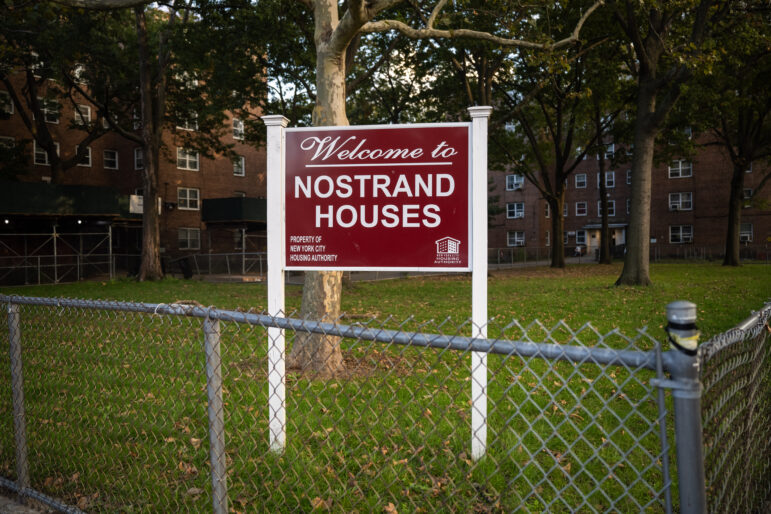Following a 30-day voting period that starts Nov. 8, Nostrand could be the first New York City Housing Authority development to join the Preservation Trust, a new public entity that can issue bonds to fund repairs. Similar votes at other NYCHA campuses are expected to take place next year.
Scott Heins
Tenants at NYCHA’s Nostrand Houses will be the first to vote on whether to join the new Preservation Trust, convert to the PACT initiative or remain in Section 9.
With just over two weeks to go, NYCHA residents at the Nostrand Houses in Sheepshead Bay are preparing to cast votes that will impact the future of their homes.
Following a 30-day voting period that starts Nov. 8, Nostrand could be the first New York City Housing Authority development to join the Preservation Trust, a new public entity that can issue bonds to fund repairs.
Residents could alternatively vote to participate in the Permanent Affordability Commitment Together (PACT) initiative, through which NYCHA enters long term leases with private developers, or to remain in traditional Section 9 public housing.
PACT and the Trust are part of a strategy to tackle NYCHA’s growing capital repair needs—an estimated $78.3 billion-worth over the next 20 years—in the absence of more direct government funding. Both promise that residents will continue to pay no more than 30 percent of their income on rent.
Through PACT, which has already converted 37,000 public housing units since its 2015 launch, private developers brought in to manage NYCHA developments can fund repairs with tax credits, mortgages and bonds.
The Trust, passed into law last June by Gov. Kathy Hochul, has yet to be tested. Apartments would be leased to the new entity, which would then issue bonds to cover repairs using additional federal funding obtained through Tenant Protection Vouchers (TPVs), which are worth double NYCHA’s current federal subsidy.
Apartments at Nostrand are in poorer condition than 80 percent of their peer developments, according to Mayor Eric Adams’ administration. The estimated cost to rehabilitate across the 16 buildings is $600 million.
Last week, roughly 50 residents packed into a room at CAMBA Sheepshead Bay Cornerstone, a community center at the neighboring campus, filled with fliers and coloring books for children.
Deborah Millan was among the first to take a seat. She has lived at Nostrand for 42 years. After being separated from a partner and having two young children to raise, Millan said that she found a safety net in public housing. “It was really a beautiful place to live,” she said.
But over the decades, conditions at the development deteriorated. “Small things get repaired, like a drain, but there’s a feeling of abandonment,” she explained.
Millan’s hope, she said, is to see both initial repairs as well as longer term upkeep to maintain those conditions. “I just feel that if the buildings were kept up better, you would see more dignity for the people who live there,” she said. “Perhaps there wouldn’t be piss in the elevator, to be frank.”
Barbara McFadden, the tenant association president at Nostrand Houses and board member for Preservation Trust, led the Oct. 19 meeting. She told residents that although she is a supporter of the Trust, her role is not to sway tenants in any direction. Yet she encouraged the crowd to keep an open mind to new opportunities.
Throughout the meeting, she compared the struggling housing development to a struggling student. “If my child’s not learning in that classroom, I’m talking to the principal, I’m having my child put out of that classroom and put in another classroom where she can learn,” McFadden said. “Just like if you feel like you live at Nostrand Houses and you’re under Section 9 and you feel like you’re not getting results, you try something else.”
The crowd also heard from Vlada Kenniff, formerly of NYCHA’s Asset and Capital Management Division, who had become the Trust’s inaugural president five weeks prior.
“It’s not about making [properties] pretty, it’s not about shiny things, it’s about fixing the systems,” she said. “I’m here to deliver on that.”
Scott Heins
A flier for an outreach event about the Preservation Trust taped to the door of an apartment at the Nostrand Houses.
The Trust, Kenniff added, is going to keep the jobs of current NYCHA workers, 22 percent of whom live in public housing. PACT, by contrast, allows partnering developers to bring in their own management teams.
This was a major selling point for Infinite George, a field representative of the Greater New York Laborers-Employers Cooperation and Education Trust (LECET). George does not live at Nostrand, but came with a stack of pro-Trust flyers to the meeting.
“It’ll… keep the residents that gained meaningful employment through NYCHA—it’ll keep them employed as unionists as well,” he said.
To complete needed fixes in apartments, some tenants may need to relocate, Keniff said. According to NYCHA, the amount of time depends on the site, but there is an anticipated three-to-six-month window.
Tenant Herman Cruz demanded reassurances that he would be able to return.
“If a resident is to move out of their apartment, they’re coming back to that same exact apartment—where can I find that online or in writing?” he asked.
Tamika Brown, a NYCHA manager, chimed in with a response. “If you have to be temporarily relocated, you will sign a temporary lease for an apartment and once your repairs are done, you will go to your other apartment,” Brown said.
Kenniff added that she is working with NYCHA to hold vacant apartments at Nostrand and Sheepshead Bay Houses, a neighboring development, to ensure that tenants will stay on the property.
She also tried to assure Cruz and others that a third-party vendor cannot stop midway through the project if the cost of construction exceeds their expectation.
Under the Trust legislation, she said, a budget is established at the start of the process. Should the Trust pick a third-party vendor to do the repairs, the vendor would need to stay within that budget and complete all the tasks in the contract.
Before the meeting was through, one tenant pulled out a folded piece of paper from his shirt pocket and declared that the flier made him more confused about the difference between Preservation Trust and PACT. It was the flier that George of LECET had left out before the meeting commenced.
“It’s telling me to pick the Trust,” the tenant said.
Other residents began examining the flier to figure out who it was from. Courtney Yu, the state affairs officer at NYCHA, assured tenants that the paper was not from the housing authority.
“There’s a specific organization that wants you to vote a certain way and they’re sharing their opinions with you, and that’s okay,” Yu said.
As the meeting came to a close, Yu reminded tenants that voting will begin online and by mail on Nov. 8. In-person voting will take place between Nov. 28 and Dec. 7 at their engagement office, located on the campus at 2344 Bragg St., apartment 1C.
There are more meetings about the vote planned for the coming week, including this Thursday and Nov. 1, at the community center located at 3679 Nostrand Ave. NYCHA said it has so far contacted 67 percent of tenants to let them know about the vote through phone calls, door knocking and meetings.
“We just want to make sure that you are all informed and we want to encourage you to vote because this is really important,” Yu said.
Closer to the voting period, tenants can also expect flyering by Residents to Preserve Public Housing (RPPH), co-founded by Marquis Jenkins, a former public housing resident opposed to both the Trust and PACT plans.
“RPPH firmly believes that the most sustainable way to protect, preserve and modernize NYCHA homes is through all levels of government funding public housing under Section 9,” Jenkins told City Limits by email.
Millan, who walked out of the Oct. 19 meeting early, said she felt closer to a decision, if still uneasy.
“It’s disturbing the choices we have,” she said. “I would be opting for the Preservation Trust only because it seems to limit the risk of privatization.”
Do you have questions or opinions about the upcoming vote, or about NYCHA’s PACT and Preservation Trust plans? City Limits wants to hear from you!
Send your questions and comments to NYCHA@citylimits.org. Your feedback will help inform City Limits’ future reporting on these issues.
We also accept oped submissions! If you’re interesting in submitting an opinion piece, email jeanmarie@citylimits.org.




